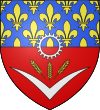Seine Saint Denis
| Seine-Saint-Denis | ||
|---|---|---|
| Department | ||

Prefecture building of the Seine-Saint-Denis department, in Bobigny
|
||
|
||
 Location of Seine-Saint-Denis in France |
||
| Coordinates: 48°54′N 02°29′E / 48.900°N 2.483°ECoordinates: 48°54′N 02°29′E / 48.900°N 2.483°E | ||
| Country | France | |
| Region | Île-de-France | |
| Prefecture | Bobigny | |
| Subprefectures |
Le Raincy Saint-Denis |
|
| Government | ||
| • President of the General Council | Claude Bartolone (PS) | |
| Area | ||
| • Total | 236 km2 (91 sq mi) | |
| Population (2013) | ||
| • Total | 1,552,482 | |
| • Rank | 6th | |
| • Density | 6,600/km2 (17,000/sq mi) | |
| Time zone | CET (UTC+1) | |
| • Summer (DST) | CEST (UTC+2) | |
| Department number | 93 | |
| Arrondissements | 3 | |
| Cantons | 21 | |
| Communes | 40 | |
| ^1 French Land Register data, which exclude estuaries, and lakes, ponds, and glaciers larger than 1 km2 | ||
Seine-Saint-Denis (French pronunciation: [sɛnsɛ̃dəni]) is a French department located in the Île-de-France region. Locally, it is often referred to colloquially as quatre-vingt treize or neuf trois (i.e. "ninety-three" or "nine three"), after its official administrative number, 93.
The learned and rarely used demonym for the inhabitants is Séquano-Dionysiens; more common is Dionysiens.
Seine-Saint-Denis is located to the northeast of Paris. It has a surface area of only 236 km², making it one of the smallest departments in France. Seine-Saint-Denis and two other small departments, Hauts-de-Seine and Val-de-Marne, form a ring around Paris, known as the Petite Couronne ("little crown"). They form, together with Paris the Greater Paris since January 1st 2016.
Seine-Saint-Denis is made up of three departmental arrondissements and 40 communes:
Seine-Saint-Denis was created in January 1968, through the implementation of a law passed in July 1964. It was formed from the part of the (hitherto larger) Seine department to the north and north-east of the Paris ring road (and the line of the old city walls), together with a small slice taken from Seine-et-Oise.
...
Wikipedia


